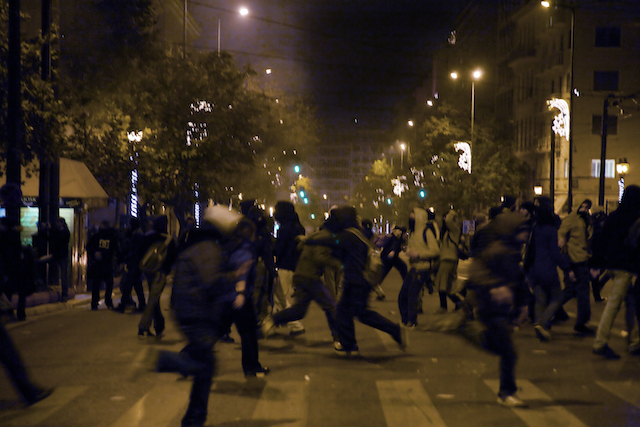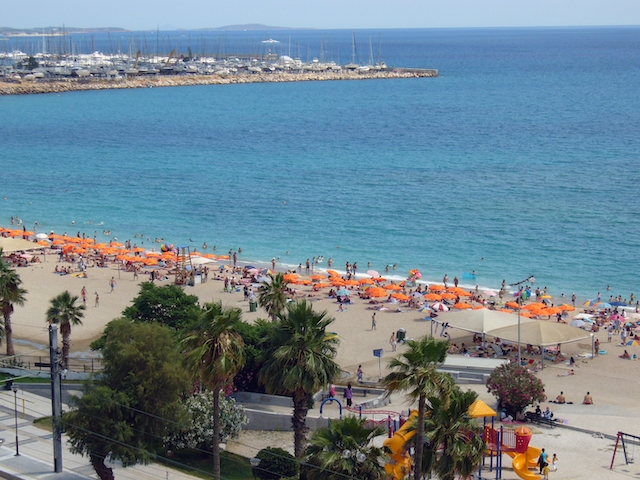Neurotics, Freud thought, are ‘anchored somewhere in their past’. Fixated on the memory of some earlier happy time from which they cannot free themselves, they find the present and future unbearable. Most modern nation-states take a similarly fixated view of themselves, agonising over how to make good on a supposedly glorious past. The group exhibition a.O. – b.c.: An Audiovisual Diary deals with one version of this, questioning not just who the Greeks are or were, but the contemporary Greek national imaginary.
It doesn’t, of course, tell the whole story of modern Greece: independence from the Ottomans, Nazi occupation, dictatorship, the democratic present. This is hardly a narrative of triumph – nobody except the far right would want that, even if it were possible. Instead, by limiting the historical scope, but showing a vast range of works – some 60 pieces from 80 listed contributors, including paintings, videos, installations, graphics, conceptual works, photographs and more, spread between State of Concept’s space in the Filopappou district and the School of Fine Arts 3km away – curators Vicky Zioga, Electra Karatza, Maria Adela Konomi, Lydia Markaki and iLiana Fokianaki show work produced after the 2004 Olympic Games but before the 2010 sovereign debt crisis, as the initials in the title hint.
The opaque title and sheer volume of eclectic work makes a.O. – b.c. less a diary than a neurotic symptom, condensing and displacing the many effects of a collective trauma: the sudden shift from petty nationalistic pride during the Olympics to the bailouts, humanitarian crisis, riots, police brutality and the rise of the far right. Austerity might officially be over, but the wounds to the Greek psyche persist, so viewing a.O. – b.c. is like seeing all those unresolved feelings up close, unfiltered, in something like the transference process. We can clarify some of this by making five works stand in for the whole exhibition. While this isn’t ideal, they reflect its main theme: how the Olympics and the crisis intensified already existing neuroses about Greek identity. The real question, of course, is which ‘past’ it is anchored in and how and why this is so.
This is very clear in Bill Balaskas’s short video Parthenon Rising (II) (2010), downstairs in the Filopappou space. One dramatic image, the imposing, postcard-perfect Parthenon at night, is struck by flashes of light in time to thundering piano music. The radiance could be coming from fireworks from the Olympics’ opening ceremony – or Molotov cocktails thrown at the police. We aren’t told, seeing only the chiaroscuro effect. Either way, the Parthenon is a convenient ideological stand-in for the heroic birth of a whole civilisation (if not civilisation itself), now a burden weighing down attempts to create something new, with four centuries of Ottoman influence airbrushed out. In Balaskas’s film, the ancient monument can reflect only indirectly how things are now, since we never see what is really happening for what it is.

Leda Papaconstantinou’s film The City and the Sunset (2007) shows the baking Athenian sun sink behind the mountains. The Ancient Greeks had a cyclical concept of time modelled on observable nature (day and night and seasonal changes), represented by the pantheon of gods. The mechanical gaze of the camera, however, imposes a modern notion of what Hannah Arendt called ‘rectilinear’ time, moving in one relentless direction. Papaconstantinou still manages to evoke the wonder and terror of the sunset as it slowly fades from view, despite the fact that images of this kind have, in less sensitive hands, been reduced to marketable kitsch for stock photos or computer screensavers.
A certain kind of terror is evident in December Riots (2008) by photojournalist Eirini Vourloumis, showing masked protesters and heavily armoured riot police swathed in acrid teargas. The riots were set off when police murdered fifteen-year-old student Alexandros Grigoropoulos, but expressed other grievances relating to the global financial crisis. Vourloumis’s images capture the rage of people who feel they will always be oppressed, never determining their own lives, just as a preceding generation of Greeks lived under the thumb of a US-backed military junta. Vangelis Vlahos picks up on this history with a different take on the gap between the national imaginary and real life. His framed photocopy of a 2004 US ambassador’s report on Greece’s national defence capacities reminds us that Greece still has budget-swallowing strategic commitments as a NATO member, despite the fact that, at the height of the crisis, middle-class people struggled to feed their children, and that refugees still sleep on the streets of Athens.
Artist duo Barking Dogs United’s Property Offer (2009), three images from Edem Beach along the luxurious coastline at Palaio Faliro in the south of Athens, brings institutional critique to bear on the crisis. The collective take what look like, under normal circumstances, bland tourist snaps of tanning bodies in the sun. More deviously, however, they place the beach’s orange umbrellas across the sand to spell out, in English, ‘FOR SALE’. This can only be seen from above, as an image pulled from Google maps illustrates, but, with black humour, draws attention to growing economic inequality and the degradation of the public sphere. The lost polis is yet another Athenian invention: easily fetishised, impossible to live up to, its very absence reminds us that there is no truly happy past for this or any other nation.
a.O. – b.c.: An Audiovisual Diary at Athens School of Fine Arts and State of Concept, Athens, through 1 February
From the January/February 2020 issue of ArtReview
